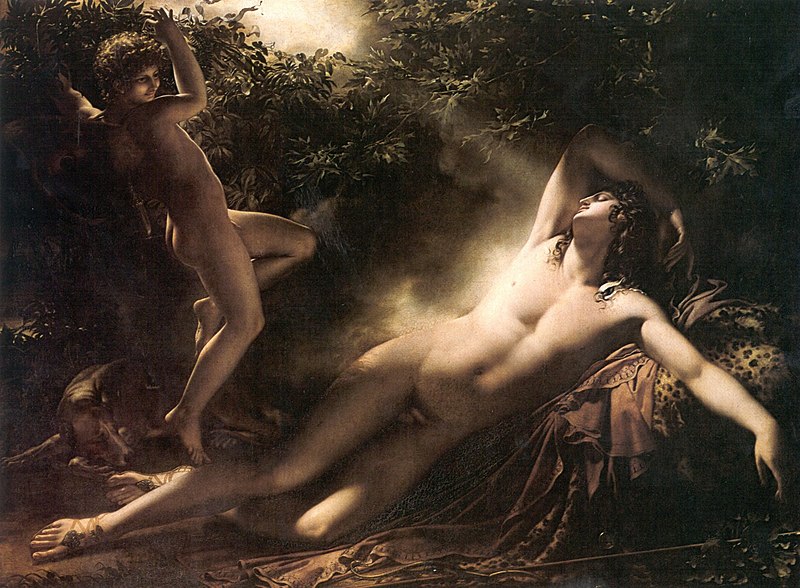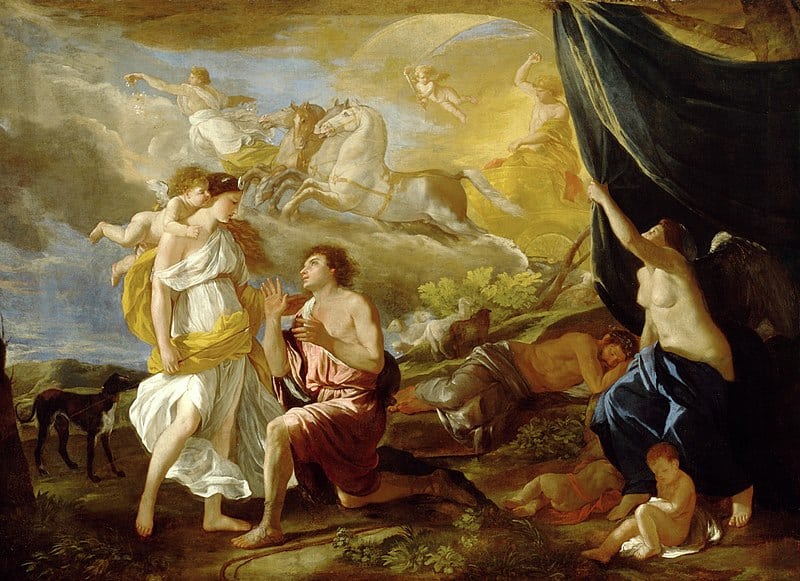Few tales from Greek mythology capture the heart quite like the story of Endymion. A mortal of incomparable beauty, his story is one of passion, enchantment, and the ethereal love of a goddess. As we journey through the annals of time, let’s unravel the mesmerizing tale of this shepherd and his divine admirer.
Endymion Key Facts
| Parents | Aethlius and Calyce |
| Partners | Selene |
| Siblings | Paeon |
| Offspring | Fifty daughters |
| Other names | – |
| Roman name | Endymion |
| Best Known Myth | Eternal slumber under Selene’s gaze |
Name and Etymology
Endymion’s name, though echoing through the corridors of time, doesn’t have a clear etymology. Some scholars believe it might be derived from the Greek word “endyein,” meaning “to dive into” or “to enter.” This could metaphorically allude to his eternal sleep. His Roman counterpart shares the same name, a rarity in the world of mythology. Throughout various tales, he’s often referred to by epithets that highlight his beauty and the tragic romance he shared with Selene, the moon goddess.
Endymion’s Family and Relationships
Born to Aethlius and Calyce, Endymion hailed from the lineage of the Titans. His family tree, though not as illustrious as some, still held significance in the annals of Greek myths. His early life remains shrouded in mystery, with only fragments of tales hinting at his childhood. However, it’s his adult life that truly captivates the soul.
Endymion’s love story with Selene, the moon goddess, is the stuff of legends. Struck by his beauty, Selene’s affection for him was so profound that she wished for him to remain ageless and asleep forever, just so she could gaze upon him without the interference of time or wakefulness.
Myths about Endymion
The Eternal Slumber
On a fateful evening, Selene, the radiant moon goddess, chanced upon a sleeping Endymion. His beauty, so profound and ethereal, ensnared her heart instantly. Overwhelmed by a love so deep and fearing the ravages of time upon his visage, she approached Zeus with a plea.
She wished for Endymion to remain in eternal slumber, forever youthful, so she could gaze upon him every night. Zeus, often indifferent to mortal affairs, was moved by the depth of Selene’s love.
He granted her wish, ensuring that Endymion would forever rest in a cave on Mount Latmus, untouched by age or consciousness. And so, every night, under the silvery embrace of the moon, Selene would descend to kiss her beloved, finding solace in his undying beauty.
The Fifty Daughters
The bond between Selene and Endymion wasn’t just a tale of ethereal love; it bore fruit in the form of fifty daughters. The myths surrounding their birth are as enchanting as they are varied.
Some tales suggest that during his perpetual sleep, Selene would visit him, and from their union, fifty daughters were born. Each of these daughters symbolized a lunar month, weaving an intricate tapestry of time and love.
Their existence further solidified the connection between the mortal shepherd and the celestial goddess, making their story one of the most poignant tales in Greek mythology.
Depiction And Characteristics
Endymion’s appearance is often described as that of a young man in the prime of his youth, with features so striking that even a goddess couldn’t resist. Symbols associated with him are few, but the moon, due to his connection with Selene, is a recurring motif. His personality, though not elaborated upon in many myths, can be inferred from his tales. He was likely a kind, gentle soul, given the depth of Selene’s affection for him.
Representations Of Endymion In Art
Endymion’s story has inspired countless artists over the centuries. One of the most renowned depictions is the painting “Endymion” by Anne-Louis Girodet, which beautifully captures the essence of his eternal sleep.

Another masterpiece is “Selene and Endymion” by Nicolas Poussin, which portrays the poignant moment of their meeting.

Mentions in Ancient Texts
Endymion’s tale, while not as prolifically mentioned as some of the other Greek heroes, has left an indelible mark on ancient literature. The earliest and perhaps the most significant mention can be traced back to Homer’s magnum opus, the “Iliad.” In this epic, Endymion is alluded to not as a lover of a goddess, but as a handsome shepherd, a mortal who caught the eye of the divine. This brief mention, though not delving deep into his story with Selene, sets the stage for later poets and writers to explore and expand upon.
Another text that beautifully narrates the tragic love story between the mortal and the moon goddess is Ovid’s “Metamorphoses.” Ovid, with his characteristic flair for drama and detail, paints a vivid picture of their romance. He speaks of Selene’s undying love, her plea to Zeus, and the eternal sleep that Endymion was cast into. A poignant line from the text reads, “For love of him, the Moon delays her course and lingers on.” This line encapsulates the essence of their tale, highlighting the lengths to which love can drive even the divine. Through these texts and others, the legend of Endymion has been immortalized, ensuring that his story is passed down through the ages.
Frequently Asked Questions
His unparalleled beauty and the purity of his soul captivated Selene, leading to their legendary love story.
He rests in eternal slumber in a cave on Mount Latmus.
Some myths suggest Selene bore him these children during his eternal sleep, with each daughter symbolizing a lunar month.
Yes, Selene pleaded with Zeus to grant Endymion eternal youth and sleep, a wish he granted.
The Roman counterpart of Endymion retains the same name, and his story largely mirrors the Greek version.
The moon is the primary symbol due to his deep connection with Selene.
And there you have it, the enchanting tale of Endymion, a testament to the timeless allure of Greek mythology. Whether you’re a seasoned scholar or a curious novice, stories like these never cease to amaze.
Featured Image Credit: Victor Florence Pollett, Public domain, via Wikimedia Commons
